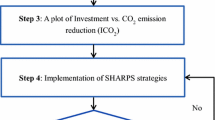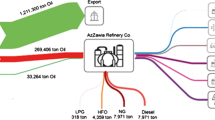Abstract
Purpose
Developing a robust method for CO2 allocation in oil refineries is an ongoing debate within the life cycle assessment (LCA) community. Several methodologies reported in the literature, mostly performing sequential and iterative calculations, tend to be biased toward diesel at the expense of gasoline, failing to properly consider the role played by hydrogen. This paper develops a new non-iterative refinery CO2 allocation method to explore the concept of customized allocation to overcome the inherent bias in standard methods.
Methods
The allocation methodology is based on a system of linear equations built around the material and energy balances of a refinery. After describing the process of building such system, it is shown that the carbon allocation values of all final products and intermediate streams are directly obtained by solving it. A numerical example of CO2 emission allocation to major refinery products is provided from an optimized refinery linear programming (LP) case for the European refining industry, based on literature projections for 2020.
Results and discussion
The paper presents the key emission sources in the European refinery sector, and by using a standard mass-based allocation technique, we show that the carbon intensities of refined petroleum products derived using the non-iterative method are consistent with other studies. We confirm the findings that the standard allocation typically used in attributional refinery LCA tends to reward diesel to the detriment of gasoline. We attempted reconciling this by applying a reallocation factor to customize the CO2 allocation to represent the “real” economic purposes of process units reflecting the constraints European refineries face today. This moderated the octane production effects given the important role the reformer plays in hydrogen co-production, where the emission burden of highly knock-resistant reformate is redistributed to hydrogen and carried through to diesel.
Conclusions
By customizing the allocation of CO2, we demonstrated that the differences between a consequential and an attributional approach in refinery LCA can partly be reconciled. We now run into the risk of increasing the subjectivity of the attributional method by using “judgment calls” to decide on the choice of weightage to be applied. We invite the wider LCA practitioners to further investigate the use of this new non-iterative method for allocating CO2 and explore the concept of reallocation factors as means to customize emission allocation.











Similar content being viewed by others
References
Abdul-Manan AF (2015) Uncertainty and differences in GHG emissions between electric and conventional gasoline vehicles with implications for transport policy making. Energy Policy 87:1–7
Abdul-Manan AF (2017) Lifecycle GHG emissions of palm biodiesel: unintended market effects negate direct benefits of the Malaysian economic transformation plan (ETP). Energy Policy 104:56–65
Abdul-Manan AF, Arfaj A, Babiker H (2017) Oil refining in a CO2 constrained world: effects of carbon pricing on refineries globally. Energy 121:264–275
ANL (2013) Greenhouse gases, regulated emissions and energy use in transportation model. Argonne National Laboratory, Argonne
Bessou C, Chase LD, Henson IE, Abdul-Manan AF, Mila-i-Canals L, Agus F, Chin M (2014) Pilot application of PalmGHG, the RSPO greenhouse gas calculator for oil palm products. J Clean Prod 73:136–145
Bouvart F, Saint-Antonin V, Gruson J-F (2013) “Well-to-tank” carbon impact of fossil fuels. French Environment and Energy Management Agency (ADEME)
Bredeson L, Quiceno-Gonzalez R, Riera-Palou X, Harrison A (2010) Factors driving refinery CO2 intensity, with allocation into products. Int J Life Cycle Assess 15:817–826
CARB (2009) Proposed regulation to implement the low carbon fuel standard. Volume I. Staff Report: Initial Statement of Reasons. California Air Resources Board
Cherubini F, Jungmeier G (2010) LCA of a biorefinery concept producing bioethanol, bioenergy, and chemicals from switchgrass. Int J Life Cycle Assess 15(1):53–66
CONCAWE (2013) Oil refining in the EU in 2020, with perspectives to 2030. CONCAWE, Brussels
CONCAWE (2017) Estimating the marginal CO2 intensities of EU refinery products. CONCAWE, Brussels
Dale BE, Kim S (2014) Can the predictions of consequential life cycle assessment be tested in the real world? Comment on “Using attributional life cycle assessment to estimate climate-change mitigation…”. J Ind Ecol 18(3):466–467
Daystar J, Venditti R, Kelley SS (2017) Dynamic greenhouse gas accounting for cellulosic biofuels: implications of time based methodology decisions. Int J Life Cycle Assess 22:812–826
EC. (2009) Directive 2009/28/EC of the European parliament and of the council of 23 April 2009 on the promotion of the use of energy from renewable sources and amending and subsequently repealing directives 2001/77/EC and 2003/30/EC. Off J Eur Union:16–62
El-Houjeiri HM, Vafi K, Duffy J, McNally S, Brandt AR (2015) Oil production greenhouse gas emissions estimator OPGEE v1.1 draft E
EPA (2010) Part II Environmental Protection Agency. 40 CFR Part 80 Regulation of fuels and fuel additives: changes to Renewable Fuels Standard Program; Final Rule. Washington: National Archives and Records Administration
European Commission (2015) Reference document on best available techniques for mineral oil and gas refineries. Seville, Integrated Pollution Prevention and Control (IPPC)
European Union (2016) BioGrace. (The Intelligent Energy Europe Programme) Retrieved from http://www.biograce.net/
Furuholt E (1995) Life cycle assessment of gasoline and diesel. Resour Conserv Recycl 14:251–263
Han J, Forman GS, Elgowainy A, Cai H, Wang M, DiVita VB (2015) A comparative assessment of resource efficiency in petroleum refining. Fuel 157:292–298
Hertwich E (2014) Understanding the climate mitigation benefits of product systems: comment on “using attributional life cycle assessment to estimate climate-change mitigation”. J Ind Ecol 18(3):464–465
ICCT (2014) Upstream emissions of fossil fuel feedstocks for transport fuels consumed in the European Union. The International Council on Clean Transportation, Washington DC
JEC (2014a) Well-to-Wheels analysis of future automotive fuels and powertrains in the European conext, version 4.a. Joint Research Centre-EUCAR-CONCAWE collaboration
JEC (2014b) Well-to-tank appendix 2—version 4a. Joint Research Centre-EUCAR-CONCAWE collaboration. Ispra, European Commission
JRC-IEA (2010) International reference life cycle data system (ILCD) handbook—general guide for life cycle assessment—detailed guidance. Publications Office of the European Union, Luxembourg Retrieved from http://lct.jrc.ec.europa.eu/
Luo L, van der Voet E, Huppes G, Udo de Haes HA (2009) Allocation issues in LCA methodology: a case study of corn stover-based fuel ethanol. Int J Life Cycle Assess 14(6):529–539
Plevin R, Delucchi M, Creutzig F (2013) Using attributional life cycle assessment to estimate climate-change mitigation benefits misleads policy makers. J Ind Ecol 18(1):73–83
Schmidt JH (2008) System delimitation in agricultural consequential LCA. Int J Life Cycle Assess 13(4):350–364
Searchinger T, Heimlich R, Houghton R, Dong F, Elobeid A, Fabiosa J, Yu T-H (2008) Use of U.S. croplands for biofuels increases greenhouse gases through emissions from land-use change. Sci 319(5867):1238–1240
thinkstep (2012) GaBi 6 Professional database Retrieved from http://www.gabi-software.com/support/gabi/gabi-6-lci-documentation/
Wang M, Lee H, Molburg J (2004) Allocation of energy use in petroleum refineries to petroleum products. Int J Life Cycle Assess 9(1):34–44
Author information
Authors and Affiliations
Corresponding author
Additional information
Responsible editor: Matthias Finkbeiner
Rights and permissions
About this article
Cite this article
Gordillo, V., Rankovic, N. & Abdul-Manan, A.F. Customizing CO2 allocation using a new non-iterative method to reflect operational constraints in complex EU refineries. Int J Life Cycle Assess 23, 1527–1541 (2018). https://doi.org/10.1007/s11367-017-1380-1
Received:
Accepted:
Published:
Issue Date:
DOI: https://doi.org/10.1007/s11367-017-1380-1




